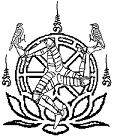Purpose/Effects
A simple and effective means to connect with our environment in a direct ways, and further cultivate our awareness, is to direct our attention to the many noises that are constantly around us. Intentionally paying attention to these sounds can aid us to come back into the present by anchoring our unruly mind on a constantly changing object, reflect on Anicca (change/uncertainty), and further refine how we hear the world around us thus making listening deeply during a conversation much easier.
Method
Sit and pay close attention to the sounds of the world around you.
Instructions
Meditation on sounds is practised in Mindfulness Based Interventions, and found in various religious/spiritual traditions. Some instructions use deliberately made noises for the practice, such as the ringing of a bell, claps, or other noises.
Within Buddhism this practice stems back to the instructions given by the Buddha in the early texts to Bāhiya (Ud1.10). Although In other references to a meditation on sounds practice may, in fact, show that this was practiced for dispassion toward sense objects in general (SN 35.95).
A related practice which focuses on the "inner sound" is taught within the Hindu tradition, with a similar practice called “The Sound of Silence” or “Nada Meditation” taught By Luang Por Sumedho and Ajahn Amaro.
A simple and effective means to connect with our environment in a direct ways, and further cultivate our awareness, is to direct our attention to the many noises that are constantly around us. Intentionally paying attention to these sounds can aid us to come back into the present by anchoring our unruly mind on a constantly changing object, reflect on Anicca (change/uncertainty), and further refine how we hear the world around us thus making listening deeply during a conversation much easier.
Method
Sit and pay close attention to the sounds of the world around you.
Instructions
- Settle into a comfortable & erect posture.
- Bring your awareness to the body, focusing your attention on the sensations of touch and pressure in your body where it makes contact with the floor and any support you are using. Spend a few moments exploring these sensations, and then direct your attention to the posture, paying attention for any tension being caused by poor posture, and uneven balance, straightening and adjusting the posture to ease any discomfort.
- Now bring your awareness to the breath coming in and out of the body at the point where a sensation of breathing is most prominent - be it a sensation within the nasal passages, or the lips & mouth, chest, & abdomen movements, or anywhere else. As the breath moves in and out of your body, take several deep breaths to get fully acquainted with the sensation before allowing your breath to relax into its natural flow, allowing what is to be, especially noticing how the breath is, whether short & shallow; or long & deep.
If there is any discomfort or strain with the breathing this may show a unconscious controlling influence on the breath, so if it persists, breathe deeply a few times again and experiment with the breathing to find a rhythm the body is comfortable with before once again relaxing into the breath
- Move your attention to the sounds that are present around you in this moment. There is no need to search for sounds, simply allow whatever sounds there are too fill your ears while simply hearing sounds near and far away.
- Notice any judgements, identifications, labelling, and thoughts about the sounds. Let them pass away, and simply focus on hearing the sounds themselves.
- Be aware that sounds arise and fade away, and notice if there are any spaces between sounds.
- At some point the mind will stray away from its object of focus to thoughts, moods, planning, daydreams, or simply drifting along with the sensations in a state similar to sleep. This is just what the mind does daily, simply following its normal routine of trying to find pleasure, not that you are doing anything wrong or proof one cannot meditate. When you notice that your focus has not been on the breath this is being clearly aware & an engaging in the practice of being fully aware of the present moment! You should know what state the mind has been in & bring the focus back to the breath. No-matter how often you notice the mind wandering off keep bringing it back to the last area you were focusing on.
- Before you finish your sitting, bring your attention back to your breath for a few moments before gradually open your eyes.
Meditation on sounds is practised in Mindfulness Based Interventions, and found in various religious/spiritual traditions. Some instructions use deliberately made noises for the practice, such as the ringing of a bell, claps, or other noises.
Within Buddhism this practice stems back to the instructions given by the Buddha in the early texts to Bāhiya (Ud1.10). Although In other references to a meditation on sounds practice may, in fact, show that this was practiced for dispassion toward sense objects in general (SN 35.95).
A related practice which focuses on the "inner sound" is taught within the Hindu tradition, with a similar practice called “The Sound of Silence” or “Nada Meditation” taught By Luang Por Sumedho and Ajahn Amaro.

 RSS Feed
RSS Feed
